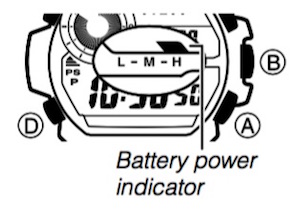Barometric Pressure Graph
Barometric pressure indicates changes in the atmosphere. By monitoring these changes you can predict the weather with reasonable accuracy. This watch takes barometric pressure readings automatically every two hours. Readings are used to produce barometric pressure graph and barometric pressure differential pointer readings.
Reading the Barometric Pressure Graph
The barometric pressure graph shows a chronological history of pressure readings.
- When display of the barometric change indicator is disabled, the graph shows the results of up to 21 barometric pressure readings (42 hours).
- When display of the barometric change indicator is enabled, the graph shows the results of up to 11 barometric pressure readings (22 hours).
- The horizontal axis of the graph represents time, with each dot standing for two hours. The rightmost dot represents the most recent reading.
- The vertical axis of the graph represents barometric pressure, with each dot standing for the relative difference between its reading and that of the dots next to it. Each dot represents 1 hPa.
The following shows how to interpret the data that appears on the barometric pressure graph.
- Rising barometric pressure indicates that upcoming weather will improve.
- Falling barometric pressure indicates that upcoming weather will deteriorate.
Note
- If there are sudden changes in weather or temperature, the graph line of past reading may run off the top or bottom of the display. The entire graph will become visible once barometric conditions stabilize.
- The following conditions cause the barometric pressure reading to be skipped, with the corresponding point on the barometric pressure graph being left blank.
- Barometric reading that is out of range (260 hPa to 1,100 hPa or 7.65 inHg to 32.45 inHg)
- Sensor malfunction








